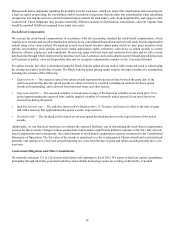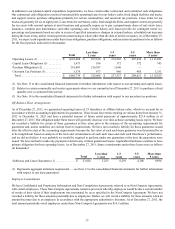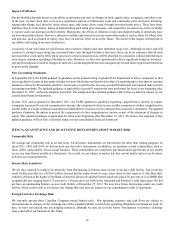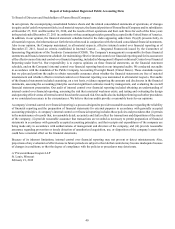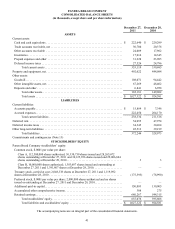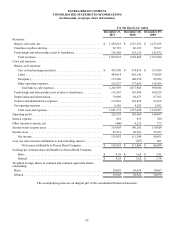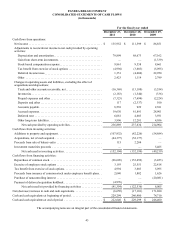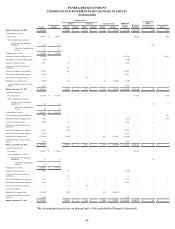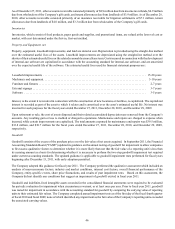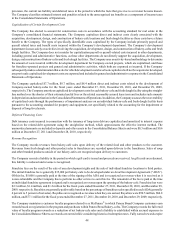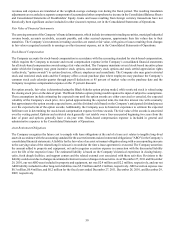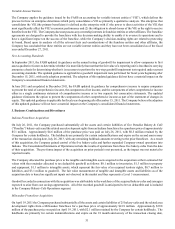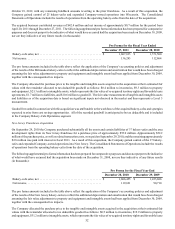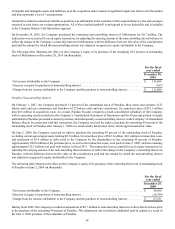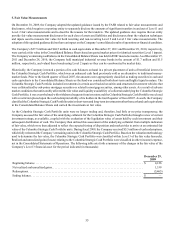Panera Bread 2011 Annual Report Download - page 54
Download and view the complete annual report
Please find page 54 of the 2011 Panera Bread annual report below. You can navigate through the pages in the report by either clicking on the pages listed below, or by using the keyword search tool below to find specific information within the annual report.46
As of December 27, 2011, other accounts receivable consisted primarily of $8.9 million due from income tax refunds, $6.9 million
due from wholesalers of the Company’s gift cards, and tenant allowances due from landlords of $3.9 million. As of December 28,
2010, other accounts receivable consisted primarily of an insurance receivable for litigation settlements of $7.1 million, tenant
allowances due from landlords of $4.0 million, and $3.3 million due from wholesalers of the Company’s gift cards.
Inventories
Inventories, which consist of food products, paper goods and supplies, and promotional items, are valued at the lower of cost or
market, with cost determined under the first-in, first-out method.
Property and Equipment, net
Property, equipment, leasehold improvements, and land are stated at cost. Depreciation is provided using the straight-line method
over the estimated useful lives of the assets. Leasehold improvements are depreciated using the straight-line method over the
shorter of their estimated useful lives or the related reasonably assured lease term. Costs incurred in connection with the development
of internal-use software are capitalized in accordance with the accounting standard for internal-use software, and are amortized
over the expected useful life of the software. The estimated useful lives used for financial statement purposes are:
Leasehold improvements . . . . . . . . . . . . . . . . . . . . . . . . . . . . . . . . . . . . . . . . . . . . . . . . . . . . . . . . . . . . . . . . . . . . . .
Machinery and equipment. . . . . . . . . . . . . . . . . . . . . . . . . . . . . . . . . . . . . . . . . . . . . . . . . . . . . . . . . . . . . . . . . . . . . .
Furniture and fixtures . . . . . . . . . . . . . . . . . . . . . . . . . . . . . . . . . . . . . . . . . . . . . . . . . . . . . . . . . . . . . . . . . . . . . . . . .
External signage . . . . . . . . . . . . . . . . . . . . . . . . . . . . . . . . . . . . . . . . . . . . . . . . . . . . . . . . . . . . . . . . . . . . . . . . . . . . .
Software . . . . . . . . . . . . . . . . . . . . . . . . . . . . . . . . . . . . . . . . . . . . . . . . . . . . . . . . . . . . . . . . . . . . . . . . . . . . . . . . . . .
15-20 years
3-10 years
2-7 years
3-7 years
3-5 years
Interest, to the extent it is incurred in connection with the construction of new locations or facilities, is capitalized. The capitalized
interest is recorded as part of the asset to which it relates and is amortized over the asset’s estimated useful life. No interest was
incurred for such purposes for the fiscal years ended December 27, 2011, December 28, 2010, and December 29, 2009.
Upon retirement or sale, the cost of assets disposed and their related accumulated depreciation are removed from the Company’s
accounts. Any resulting gain or loss is credited or charged to operations. Maintenance and repairs are charged to expense when
incurred, while certain improvements are capitalized. The total amounts expensed for maintenance and repairs was $39.5 million,
$33.8 million, and $30.7 million for the fiscal years ended December 27, 2011, December 28, 2010, and December 29, 2009,
respectively.
Goodwill
Goodwill consists of the excess of the purchase price over the fair value of net assets acquired. In September 2011, the Financial
Accounting Standards Board ("FASB") updated its guidance on the annual testing of goodwill for impairment to allow companies
to first assess qualitative factors to determine whether it is more likely than not that the fair value of a reporting unit is less than
its carrying amount as a basis for determining whether it is necessary to perform the two-step goodwill impairment test required
under current accounting standards. The updated guidance is applicable to goodwill impairment tests performed for fiscal years
beginning after December 15, 2011, with early adoption permitted.
The Company adopted this guidance for fiscal year 2011. The Company performed the qualitative assessment which included an
analysis of macroeconomic factors, industry and market conditions, internal cost factors, overall financial performance of the
Company, entity-specific events, share price fluctuations, and results of past impairment tests. Based on this assessment, the
Company did not identify any conditions that suggest an impairment of goodwill existed in fiscal year 2011.
Goodwill and indefinite-lived intangible assets recorded in the consolidated financial statements were required to be evaluated
for periodic evaluation for impairment when circumstances warrant, or at least once per year. Prior to fiscal year 2011, goodwill
was tested for impairment in accordance with the accounting standard for goodwill by comparing the carrying value of reporting
units to their estimated fair values. The Company completed annual impairment tests as of the first day of the fiscal fourth quarter
of fiscal 2010 and fiscal 2009, none of which identified any impairment as the fair value of the Company's reporting units exceeded
the associated carrying values.


